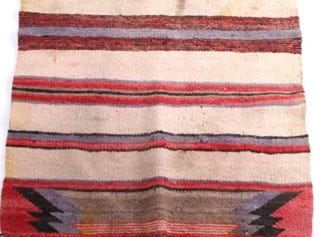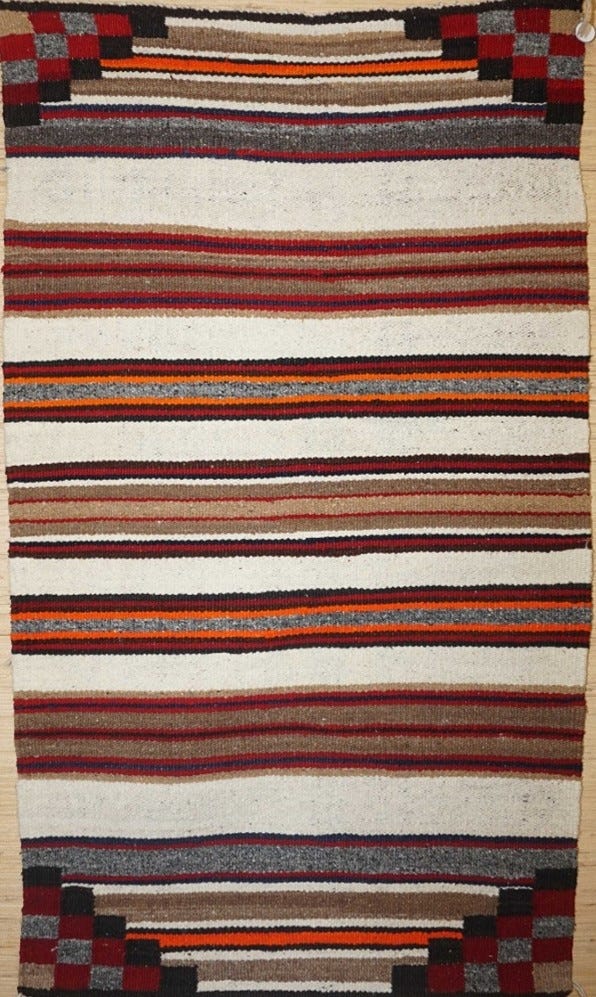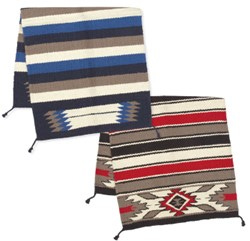Because many people read my postings for the first time, I often repeat the history of my family in the Indian trading business since it is foundational to who I am and what I have done during much of my 80+ years.
When my grandfather built his post in 1913, there were ~20 trading posts. The reservation was, and still is, the size of West Virginia. By 1950 there were 250 trading posts. Only two people ever traded with all Navajo trading posts – Dad and me. Dad passed away in 2014 at the age of 102, so I am the last person to pass on a narrative of Navajo trading posts.
In 2024 I vwill publish Navajo Trading Posts 1950 to 1980: A Reflection of Personal Experiences.
A major supply source for our trading business was the trading posts on the Navajo reservation. We traded with posts weekly for Navajo rugs and other crafts. In addition, we did a large saddle blanket business which was a separate inventory category because the business was more of a bulk business with our outlets handling large quantities. They were purchased in lots for single and double saddle blankets.
Most all saddle blankets were made in an area north of Winslow, Arizona around Leupp. There were six trading posts within 20 miles of each other. One store, Jeddito, was closer to the Hopi country and handled mostly single saddle blankets. We called on these stores about every three weeks. Each trip accounted for about 200 saddle blankets. This was mostly cash business, rather than trade because of higher volume and lower unit costs. Each trip I loaded the blankets by interlocking them individually in order to conserve space. Sometimes when I had loaded all that would fit, I would roll them and place them under my legs and stack them on the luggage rack.
We handled about 3,000 saddle blankets a year. Important to our business was making regular trips to the rez for two reasons: 1) We needed many blankets to meet our needs, and 2) we protected our inventory by keeping posts cleaned out, thus limiting access for competitors. We had two major competitors that were one-man operations and could not keep up with the demands of buying, selling, and operating on the scale that we could.
Navajo saddle blankets were the choice of horsemen because they provided good padding and absorbed sweat. They were not as finely woven as regular Navajo rugs. Typically, they were woven with stripes and an occasional corner design at one end. They are always loosely woven and two standard sizes. A single saddle blanket is 30x30 and a double is 30x60. A double provided more padding since it was folded under a saddle. The value of a Navajo rug is primarily determined by the quality of the weave. Not so with saddle blankets. For years we paid $6 each for singles and $12 for doubles. By the 80s the prices had risen to $9 and $18.
Navajo Single Saddle Blanket 30x30
Navajo Double Saddle Blanket 30x60
Our major market was horse accessory companies in Denver and Texas who wholesaled to retail stores. Most of our saddle blanket orders were shipped in burlap bales.
For years the woven saddle blanket market was dominated by Navajo blankets. In the early 80s, blankets began to appear from Mexico. They were similar to Navajo weaving and made by the Tarahumara Indians. In the 1860s when Navajos were being rounded up for relocation, many fled to Mexico and eventually intermarried. They brought with them weaving skills. Saddle blankets were a logical fit but they couldn’t spin Mexican wool as well as Navajo wool. The Mexican weavings did not compete with quality, rather it was with price. They were easily identifiable for people who knew Navajo weaving but not the general public.
Mexican Saddle Blankets
An obvious characteristic is braided, tied tassles.
By the late 70s, the Navajo saddle blanket began to diminish. The popularity of Indian jewelry carried over the saddle blanket business and people saw an opportunity for a Navajo rug at a comparatively low cost. Saddle blankets were selling for as much as $198 and sold as rugs rather than saddle blankets. The rising prices did not float all boats. The high-volume demand was wiped out by the high costs. We could not equate value with quantity and many saddle blanket weavers were squeezed from the market. We were handling about 90% of Navajo saddle blankets being produced. The saddle blankets found a new market as rugs which traditionally limited loosely woven rug and offered a new market for saddle blanket weavers. As retail prices rose, so did the prices for the weavers. A saddle blanket weaver could make a 30x60 in a week (~$18). A Navajo rug for $198 is rare regardless of the weave and the saddle blanket weavers found a niche.
Navajo rugs have distinctive types that typically come from certain areas. Between 1950 and 1980 the areas were more defined. I could tell from looking at a rug, the area where the weaver lived. Accordingly, when we needed Two Grey Hills, Storm Pattern, Vegetal Dyes, etc. we knew what trading posts had them. We made weekly trips to the rez for rugs. If we needed Storm Pattern rugs, we went to the far west of the rez and south-central for Vegetal Dye rugs. We did not deal with individual weavers on the reservation. Dad grew up on a reservation trading post and respected the micro-economies of each trading post. We knew that traders usually advanced money against rugs in production and if we went directly to a weaver, it would upset the economic balance. If weavers came to us in Gallup, we dealt directly. We usually handled about 6,000 Navajo rugs a year, not counting saddle blankets.
Of all our inventory categories, Navajo rugs were always my favorite.
You’ve read a free edition of What They Said newsletter, which goes out once per week. If you upgrade to a paid subscriber for $6 per month, you will not only be supporting this project, but you will also receive weekly issues of this newsletter. Substack provides me, as a writer, an alternative means of publication.
Next Week: Finding family







